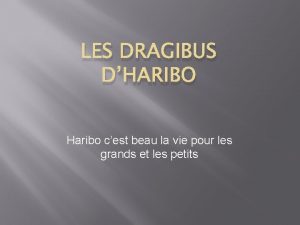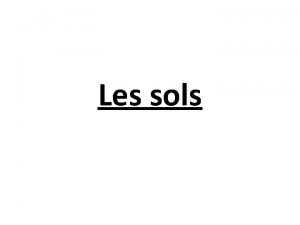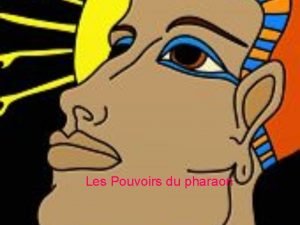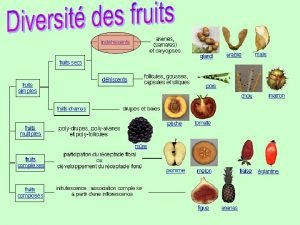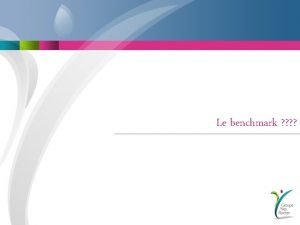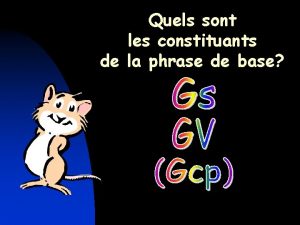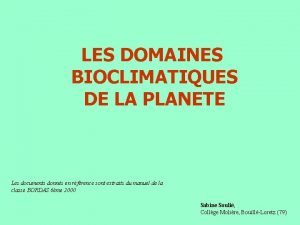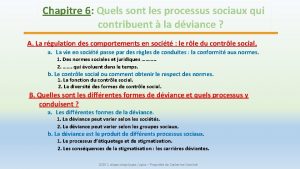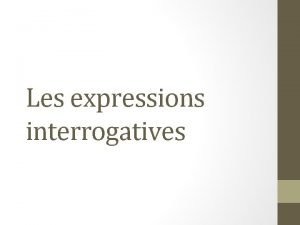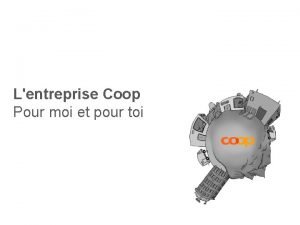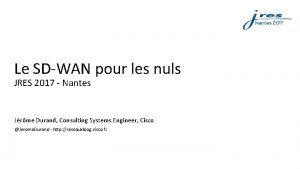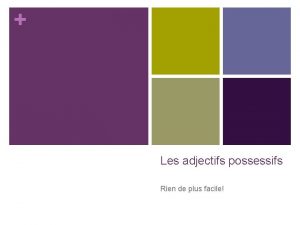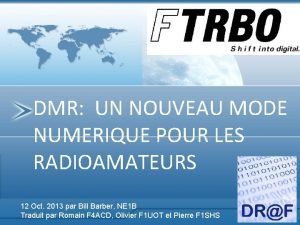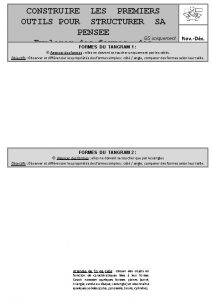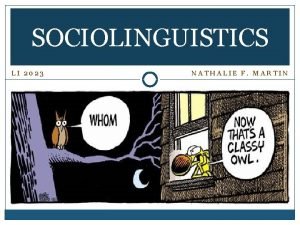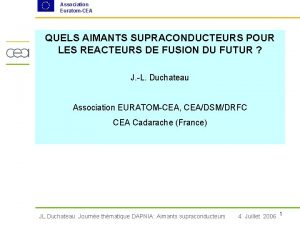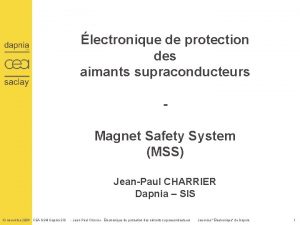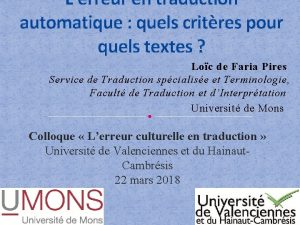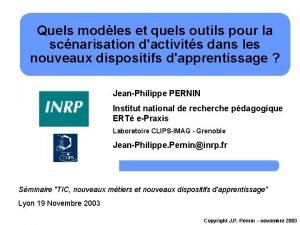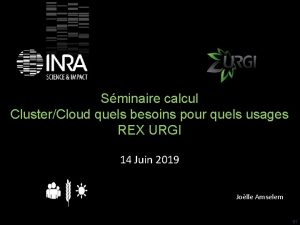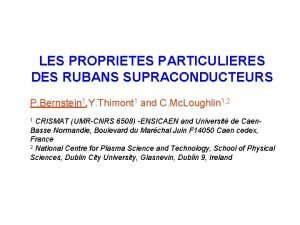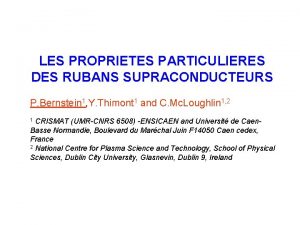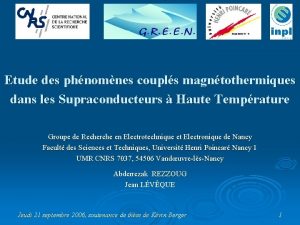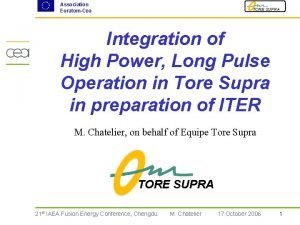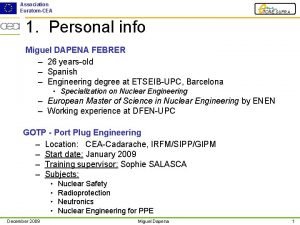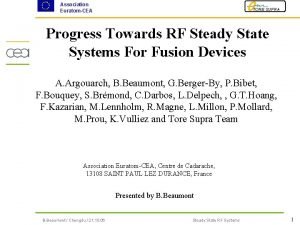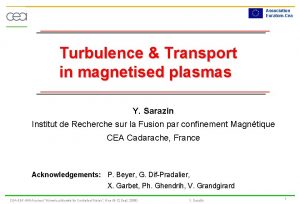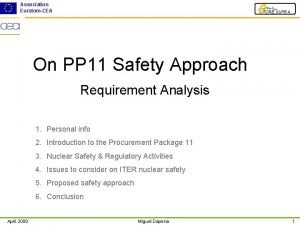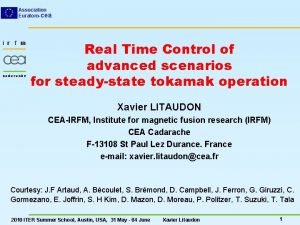Association EuratomCEA QUELS AIMANTS SUPRACONDUCTEURS POUR LES REACTEURS

























- Slides: 25

Association Euratom-CEA QUELS AIMANTS SUPRACONDUCTEURS POUR LES REACTEURS DE FUSION DU FUTUR ? J. -L. Duchateau Association EURATOM-CEA, CEA/DSM/DRFC CEA Cadarache (France) JL Duchateau Journée thématique DAPNIA: Aimants supraconducteurs 4 Juillet 2006 1

Association Euratom-CEA A few questions about future tokamak reactors - based on the experience of the model coils regarding Cable in Conduit conductors (CICC) and superconducting materials -and based on existing fusion reactors designs In terms of efficiency is there an interest to operate the magnet system at 20 K instead of 5 K. What are the requirements regarding Jnoncu for DEMO ? Are existing Nb 3 Sn or Nb 3 Al CICC able to fulfil the requirements of DEMO ? Do we need HTS material (Bi-2212) for DEMO ? JL Duchateau Journée thématique DAPNIA: Aimants supraconducteurs 4 Juillet 2006 2

Association Euratom-CEA ITER TF Model Coil built and tested in Europe (FZK) (2001 -2002) A first important industrial milestone on the way to tokamak reactors The plates system in which are inserted the conductors is very similar to the TF system of ITER JL Duchateau Journée thématique DAPNIA: Aimants supraconducteurs 4 Juillet 2006 3

Association Euratom-CEA 1. Introduction 2. Electrical power needed for the operation of the cryogenic plant of a fusion reactor 3. Performance of Nb 3 Sn in large CICC at high field 4. Average current density in the TF systems of future tokamak reactors 5. From ITER to DEMO which superconducting material for the TF system ? 6. Conclusion JL Duchateau Journée thématique DAPNIA: Aimants supraconducteurs 4 Juillet 2006 4

Association Euratom-CEA 1. Introduction : TORE SUPRA a practical experience of refrigerator associated with a fusion machine 1. 8 K Winding-pack temperature during one day of operation No large temperature excursions at 1. 8 K observed during long plasma pulses ! JL Duchateau Journée thématique DAPNIA: Aimants supraconducteurs 4 Juillet 2006 5

Association Euratom-CEA ITER Artist’s view JL Duchateau Journée thématique DAPNIA: Aimants supraconducteurs 4 Juillet 2006 6

Association Euratom-CEA 2. Electrical power associated with fusion reactor cryoplant From ITER to Fusion reactor The estimation is made on the basis of the European power plant conceptual design (EPPCS) presented at SOFT 2004 Conference (model B) (ref EPPCS). Extrapolation is generally related to machine surface or volumes ITER Fusion reactor Major radius 6. 2 m 8. 6 m Minor radius 2 m 2. 87 m Surface ( Rr) 12. 4 24. 8 Volume ( Rr 2 ) 24. 8 77 Ref EPPCSD. Maisonnier et al “The European power plant conceptual study” Presented at the 23 rd SOFT Conference (September 2004) Venice Italy. To be published JL Duchateau Journée thématique DAPNIA: Aimants supraconducteurs 4 Juillet 2006 7

Association Euratom-CEA 2. From ITER to Fusion reactor Cryogenic heat load at 4. 5 K Not linked to magnet system Cryogenic load ITER Fusion reactor Steady state Pst 11. 9 k. W 25 k. W Circulating pumps Pcirc 11. 4 k. W 15 k. W Cold compressors Pcc 4. 5 k. W 0. Cryopumps Pcp 5. 5 k. W + 30 g/s 8. 5 k. W 30 k. W Current leads Pcl 130 g/s 13 k. W 4. k. W Pulsed losses Ppl 10. 7 k. W (average) 0 Total 60 k. W 74. k. W JL Duchateau Journée thématique DAPNIA: Aimants supraconducteurs HTS current leads 4 Juillet 2006 8

Association Euratom-CEA 2. From ITER to Fusion reactor Cryogenic heat load at 80 K Cryogenic load ITER Fusion reactor Heat load at 80 K PN 2 1000 k. W 2000 k. W This cryogenic load is due to heat radiation from 300 K In ITER 700 k. W only is linked to heat radiation. This fraction is extrapolated according to the volume of the machine. JL Duchateau Journée thématique DAPNIA: Aimants supraconducteurs 4 Juillet 2006 9

Association Euratom-CEA 2. From ITER to Fusion reactor Conversion of cryogenic power to electrical power These cryogenic loads require large electrical power at the level of warm compressors. Welec = Wcryogenic/f cryoplant global efficiency : r=f T 2/(T 1 -T 2) Carnot efficiency f 0. 25 Influence of magnet temperature on cryoplant global efficiency 1/ 1/r T 2=5 K 59 236 T 2=20 K 14. 56 JL Duchateau Journée thématique DAPNIA: Aimants supraconducteurs 4 Juillet 200610

Association Euratom-CEA 2. From ITER to Fusion reactor Conversion of cryogenic power to electrical power Temperature level for cryogenic heat load 4. 5 K 80 K Cryogenic power Magnet system only 72. 5 k. W 44 k. W 2000 k. W Global efficiency 250 10 Electrical power Magnet system only 18 MW 11 MW 20 MW Operation at 20 K instead of 4 -5: 3 MW instead of 11 MW a weak benefit of 8 MW J. L Duchateau et al. “Estimation of the recycled power associated with the cryogenic refrigeration power of a fusion reactor” Nucl. Fusion 46 (2006) S 94 -S 99 JL Duchateau Journée thématique DAPNIA: Aimants supraconducteurs 4 Juillet 200611

Association Euratom-CEA The Nb 3 Sn conductors of the two ITER model coils are a very important milestone on the way to fusion reactors CSMC 51 mm x 51 mmm 40 k. A 13 T TFMC 40, 7 mm, 80 k. A, 9. 7 T JL Duchateau Journée thématique DAPNIA: Aimants supraconducteurs 4 Juillet 200612

Association Euratom-CEA 3. Sensitivity of Nb 3 Sn to strain (from TFMC experiment) From strand to coil very large loss of performance for Nb 3 Sn 0 = othermal + 0 BP(BI) ITER TF and TFMC similar cross sections Large Nb 3 Sn conductors are sensitive to stress accumulation along their characteristic thickness. JL Duchateau Journée thématique DAPNIA: Aimants supraconducteurs 4 Juillet 200613

Association Euratom-CEA 3. Sensitivity of Nb 3 Sn to strain (from TFMC experiment) From strand to coil very large loss of performance for Nb 3 Sn Jnoncu (12 T, 4. 2 K, -0. 15 %) 800 A/mm 2 Jnoncu (12 T, 4. 2 K, -0. 83 %) 287 A/mm 2 Strand specification CICC in a TF system JL Duchateau Journée thématique DAPNIA: Aimants supraconducteurs 4 Juillet 200614

Association Euratom-CEA 4. Average current density in Tokamak TF inner leg Tokamak (TF maximum magnetic Field on conductor) TF cable current density including cooling Jcable (A/mm 2) Average current density in the TF inner leg Jcond (A/mm 2) TORE SUPRA (superconducting TF) (9 T) 39 19 JET upgrade (copper TF) (8 T) 20 17 ITER (superconducting TF) (11. 8 T) 20 12 In ITER The low value of Jconductor (12 A/mm 2) is driven by the structures and not by the superconducting material JL Duchateau Journée thématique DAPNIA: Aimants supraconducteurs 4 Juillet 200615

Association Euratom-CEA 4. Average current density in Tokamak inner TF leg Cable current density in ITER TF leg Section (mm 2) Relative occupation Helium 428 33 % Copper (extra strand) 290 22 % Copper (intra strand) 250 20 % Non copper 250 20 % Wrappings 70 5% 1288 100 % Total Jcable in ITER 52. 8 A/mm 2 >> Jcond=12 A/mm 2 Non copper section (Jnoncu) occupies only a small part of the cable section JL Duchateau Journée thématique DAPNIA: Aimants supraconducteurs 4 Juillet 200616

Association Euratom-CEA 4. Average current density in TF inner leg Cable current density in TF cables According to superconducting materials, Jcable decreases as a function of magnetic field from an ideal value of 74 A/mm 2. Above 40 A/mm 2 Jcable does not affect substantially Jcond JL Duchateau Journée thématique DAPNIA: Aimants supraconducteurs 4 Juillet 200617

Association Euratom-CEA 4. Average current density in TF inner leg Non copper current density for different superconducting materials According to superconducting materials, Jnoncu decreases as a function of magnetic field. Above 150 A/mm 2 Jnoncu does not affect substantially Jcond JL Duchateau Journée thématique DAPNIA: Aimants supraconducteurs 4 Juillet 200618

Association Euratom-CEA 4. Average current density in TF inner leg magnetic field at target value (150 A/mm 2) for Jnoncu Operating temperature (K) Maximum field at target value of Jnoncu : 150 A/mm 2 (T) Nb 3 Sn as in ITER design 5. 12. 6 Nb 3 Sn (oxford strand) 5. 13. 3 Nb 3 Al 5. 13. 6 Nb 3 Sn 1. 8 15. 4 BI-2212 4. 2 50 Nb. Ti 1. 8 11. 7 Nb. Ti 5. 6. 1 Magnetic field at target value for Jnoncu is in the range 13. 3 -13. 6 T for existing industrial Nb 3 Sn and Nb 3 Al superconducting material. JL Duchateau Journée thématique DAPNIA: Aimants supraconducteurs 4 Juillet 200619

Association Euratom-CEA 5. From ITER to DEMO which superconducting material ? The crucial dimensioning role of TF inner stacking from plasma center to Tokamak central axis. TF radial extension plays an important role in tokamak dimensioning. The radial extension must remain moderate. JL Duchateau Journée thématique DAPNIA: Aimants supraconducteurs 4 Juillet 200620

Association Euratom-CEA 5. From ITER to DEMO which superconducting material ? Electricity generating reactor: DEMO High field zone in fusion reactor magnet system constitutes a very important technological stake ITER J. L Duchateau “Influence of the magnetic toroidal field value on the design of magnet systems for future fusion reactors”. 2006 Presented at the 15 th Int. Toki Conference. JL Duchateau Journée thématique DAPNIA: Aimants supraconducteurs 4 Juillet 200621

Association Euratom-CEA 5. From ITER to DEMO which superconducting material ? For DEMO (EPPCS model C) Jnoncu=150 A/mm 2 appears as a target value beyond which average current density in TF inner leg is not affected substantially. JL Duchateau Journée thématique DAPNIA: Aimants supraconducteurs 4 Juillet 200622

Association Euratom-CEA 5. From ITER to DEMO which superconducting material ? Bismuth strand Showa 0. 81 mm Ag/Bi=2. 7 At 13. 2 T effective magnetic field of DEMO (EPPCS model C) existing Nb 3 Al and Nb 3 Sn CICC can already fulfil requirements. JL Duchateau Journée thématique DAPNIA: Aimants supraconducteurs 4 Juillet 200623

Association Euratom-CEA 6. Conclusion For TF systems of future fusion reactors, the average current density is in the range of 10 A/mm 2 and is driven by the large amount of structures necessary to resist the Lorenz forces. Thereby it is possible to accept superconducting strands with low non copper current density down to 150 A/mm 2, without substantially affecting the TF radial extension of the system Due to the combined effect of differential thermal contraction and transverse forces arising in large fusion conductors, Nb 3 Sn strands developed in the framework of ITER program are at the limit of their capability at 13. 6 T, the envisaged maximum field on the conductor However, the conductor concept can certainly be improved to mitigate the effect of the transverse magnetic field on the conductor degradation and even allow higher magnetic field for demonstration reactor if needed JL Duchateau Journée thématique DAPNIA: Aimants supraconducteurs 4 Juillet 200624

Association Euratom-CEA 6. Conclusion on possible use of HTS in future fusion reactors In the present considered range of magnetic field, solutions (Bi-2212 at 4. 2 K, or Nb 3 Sn at 1. 8 K ) can be envisaged but have still to prove their economical profitability. The improvement in Jnoncuwill be beneficial to the cost by allowing a decrease of the total weight of the superconducting material in future fusion reactors. Interest could grow if higher magnetic field are considered for future fusion reactors (14 -16 T). Increasing the magnet temperature in operation from 5 K to 20 K should provide a weak benefit < 10 MWelec JL Duchateau Journée thématique DAPNIA: Aimants supraconducteurs 4 Juillet 200625
 Dragibus calories
Dragibus calories Exemple texte expressif
Exemple texte expressif Les composants de sol
Les composants de sol Quels sont les pouvoirs du pharaon
Quels sont les pouvoirs du pharaon Exemple de fruits secs indéhiscents
Exemple de fruits secs indéhiscents Benchmark étapes
Benchmark étapes Dédoublement manipulation syntaxique
Dédoublement manipulation syntaxique Les grands domaines bioclimatiques en france
Les grands domaines bioclimatiques en france Quels sont les processus
Quels sont les processus Les dons de l'esprit saint
Les dons de l'esprit saint Les trois niveaux de biodiversité
Les trois niveaux de biodiversité Indicateurs sociaux
Indicateurs sociaux Les adjectifs interrogatifs
Les adjectifs interrogatifs Toi et moi basel
Toi et moi basel Pour toutes les mamans
Pour toutes les mamans Pour les enfants du monde entier
Pour les enfants du monde entier Sd wan pour les nuls
Sd wan pour les nuls Il faut chanter pour toutes les mamans du monde
Il faut chanter pour toutes les mamans du monde Il faut chanter pour toutes les mamans du monde paroles
Il faut chanter pour toutes les mamans du monde paroles Il faut chanter pour toutes les mamans du monde
Il faut chanter pour toutes les mamans du monde Monmuse
Monmuse Les adjectifs démonstratifs s'utilisent pour
Les adjectifs démonstratifs s'utilisent pour Dmr pour les nuls
Dmr pour les nuls Construire les premiers outils pour structurer sa pensée
Construire les premiers outils pour structurer sa pensée Chiac pour les dummies
Chiac pour les dummies Ordre du jour pour les enseignants
Ordre du jour pour les enseignants
